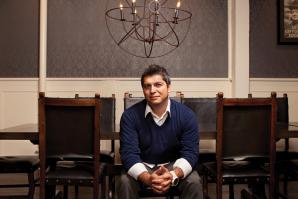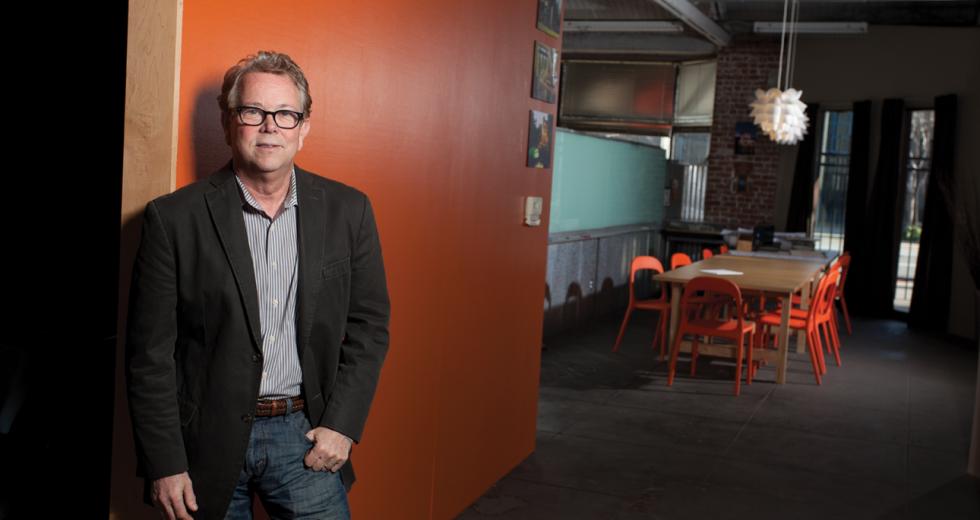Bruce Monighan knows a few things about building something out of nothing. Facing the option of unemployment or bootstrapping, the local architect started his Sacramento-based firm Monighandesign from scratch in 1982. By the early 2000s, Monighandesign was completing between 50 and 60 public and private projects annually in markets across the country and looked to expand in 2007.
And then the bottom fell out for Monighan and an entire nation of architects. The economy worsened, banks stopped lending, local and state government budgets dwindled as tax revenues fell. Then cancellations began erasing projects.
“When things started crashing really heavily by the elections of 2008, I can’t describe how scary it was,” Monighan says. “Every market got hit. It was like, ‘OK, everything that we know how to do, every client we have, every contact we have is in a market that has no money available to it. What are we going to do?’”
Ultimately, the answer was fresh thinking and new approaches for an entire industry. The 2008 recession hit every architectural market in California and across the nation, forcing Capital Region firms like Packowski Heinritz Architects and Rauschenbach Marvelli Becker to close their doors. Those that survived have done so by making fundamental changes in the way they do business. Firms with the necessary resources jumped to out-of-region and overseas markets as work dried up in the Sacramento area, while smaller firms forged partnerships with one another to exchange resources and expertise and diversify their workload.
From 2007 to 2009, total construction contract awards in California fell by about 40 percent, reports McGraw-Hill Construction Analytics. And though money has slowly trickled back into the marketplace, 2013 total construction spending is projected to be 28 percent lower than 2007 levels.
For the firms with fewer resources to expand their reach outside of California, the universal abruptness of the recession did too much damage for which no amount of trimming or downsizing could compensate. The turnaround in Sacramento is simply taking too long.
“I know several firms that have closed their doors,” Monighan says. “It was due mainly to having a healthy work flow and moderate-to-high overhead in 2007-2008 and then having all their work stop. There was simply no way they could sustain themselves in the declining market.”
Firms that have endured, such as Monighandesign, have had to drastically change their operations, getting by on diets of modest projects, focusing more on modernization and reuse of old buildings, and forging partnerships with one another in order to take on more projects without adding staff.
It is a marked change from the 1990s and early 2000s when Monighandesign, which lost more than two-thirds of its personnel in years following the start of the recession, was putting up six stores a month nationally for Gap and building a dozen 6- to 7-figure stores around the world annually for Tower Records. Projects that would be put together and started in a month back in 2005 now take two years to get off the ground, and project fees that were once $150,000 to $400,000 now are $10,000 to $30,000.
“The biggest problem is that you’ve got no backlog, so you don’t have any sense of where you’re going to be in a month, much less three months. Financial planning is all but impossible,” Monighan says. “I don’t want to say you’re living hand to mouth, but you pretty much are. So you just find yourself doing an awful lot of different work and scrambling to put them together one right after the other so you can maintain some cash flow out of it.”
Architecture is a brutally competitive industry that often sees the biggest and strongest prevail as weaker firms die out. In general, competing entities want little to do with one another; as a result of the recession, this has changed with the emergence of multi-firm communities and forums that facilitate the exchange of resources, expertise and skills.
Member groups and communities through various chapters of the American Institute of Architects emerged in the form of AIA Knowledge Communities, semi-formal national forums that allow firms to pool and leverage resources in order to take on a broader range of projects. A firm without the resources for work in a particular area, for example, can outsource a project to more efficient local entities, while another can obtain particular skill sets viable to a specific project from an architect across the country, as opposed to adding staff.
“Architects, as gregarious as they seem to be, are typically pretty inward focused and not really good at sharing with other people in their industries. This particular recession has taught us to share and be open and really communicate well as far as a collaborative environment,” Monighan says. “That’s a fundamental change in how we’ve done business on a small-firm process that is going to continue for the foreseeable future.”
As Sacramento sputtered, other well-leveraged firms looked for projects outside of the Capital Region.
“One of the important common denominators among all our firms is being able to diversify into a number of different markets. And the other is the ability to reach out and travel to new places,” says Brian Whitmore, associate principal at Williams + Paddon Architects + Planners Inc.
“We’ve had a very rich history of doing a lot of work in the Sacramento region, but we found with the downturn hitting the Sacramento region specifically hard, we’ve had to reach out to other regional areas.”
Before the downturn, almost all of Williams + Paddon’s business work was domestic, with 80 percent taking place in the Sacramento region alone. Since the recession, roughly 40 percent of the Roseville firm is now international, including the design of three tea houses in Shanghai and master planning the Monai Resort complex in the Bahamas. The firm’s work in China is particularly lucrative because it is primarily design only, with established local Chinese design institutes taking over at the developmental stages of a project, thereby creating a low-risk, high-reward exchange for the American firm.
Today, just 50 percent of Williams + Paddon’s remaining domestic projects are in the Sacramento region, which has been slow to recover even as other California regions — such as the Bay Area and Los Angeles, have bounced back.
“Now, we’re starting to see things pick back up in the Sacramento region again, and suddenly we’re talking to clients now that are making significant strides to do more work here in this region,” Whitmore says. “We seem to be benefitting from the fact that developers and business owners are making a bet this region will pay off in the near future given reports that areas like these remain good places to conduct business and still benefit from low costs of living and operating expenses.”
Modernization and adaptive reuse projects — building and updating established structures and technology — have also been essential to most firms in the Sacramento region during the downturn, as they are generally cheaper and quicker than new construction. Even larger companies such as Lionakis, Sacramento’soldest architectural firm, find that projects like remodeling a school bathroom or putting computers in hospital exam rooms have a huge impact on both the firm’s bottom line and the lives of those who use the facilities.
“I find (adaptive reuse) projects very rewarding because you are investing in something that’s already there,” says Lionakis principal Nick Docous. “Investing in what we have right now instead of creating new is a tremendous responsibility that we have as members of the community.”
Lionakis is by far the largest Sacramento-based architectural firm, employing 190 people and more than 60 architects in Sacramento, Modesto, San Francisco, Newport Beach and Honolulu. But even for big firms, the recession illustrated that relationships with clients and the community remain the most important components of sustained recovery.
“We don’t chase the big projects all over the country; we chase client relationships,” says Chuck Hack, Lionakis principal and head of business development. “That’s been the key philosophy. Especially as the recession turned on, we didn’t just focus on how to grab more work to stay afloat.”
While many firms pursued one large-scale, big-budget project after another to sustain themselves pre-recession, Lionakis’ expansion even through the downturn was based on obtaining and cultivating long-term clients. Keeping facilities current with environmental standards, staying abreast of the impact of socio-political trends (the 2010 federal health care law impacting Lionakis’ health care clients, for example), and the willingness to execute even the smallest of tasks for an employer are crucial to keeping clients happy, which Docous says in turn leads to larger projects down the road.
There are signs of growth.
Construction of single-family homes increased in California by almost 25 percent in 2012 compared to 2011, and total spending on such projects is projected at more than $10 million in 2013 — more than three times greater than any other market sector. This number is the single most important indicator of growth, says Cliff Brewis, McGraw Hill’s senior director of editorial operations.
“If you’re building (single-family) homes, eventually you’re going to build schools, roads, police and fire (stations),” Brewis says. “The fact that it hadn’t been doing very well has really hurt us, but the reason it’s coming back is that you’re finally beginning to see that recovery. You’re finally beginning to see the unemployment number fall, and people who lost homes or were under duress are getting in much better positions and driving up the demand for homes.” Even as the economy slowly turns around in 2013, recognizing the challenges businesses, firms and individuals share as a result of trying economic times has in some ways changed how architects look at projects, clients and the future of the industry.
“There was a time when we were busy and the money was easier. How much time you spent with your client wasn’t quite as important as getting the job done and moving it on because of the money that was involved with it,” Monighan says.
Now, though, knowing clients more intimately and crafting design solutions that better meet their needs allows a firm to set itself apart, Monighan says. “Because one of the things we’ve found is that the recession has put a lot of people in dire straights, and there’s a lot of commonality out there.”
Recommended For You

Putting the Fab in Pre-Fab
Modular construction cuts construction and energy costs
The final stages of construction at a trend-setting apartment project in San Francisco’s SoMa neighborhood, known by its address at 38 Harriett St., largely resembled a life-sized game of Tetris.

Intricate Infill
Architectural Designer Marvin Maldonado
“First off, I’m not an architect,” says Marvin Maldonado, a Sacramento-based building designer. He’s really more of a dreamer with a architecture degree.
But as we all know, dreams can get tricky.



